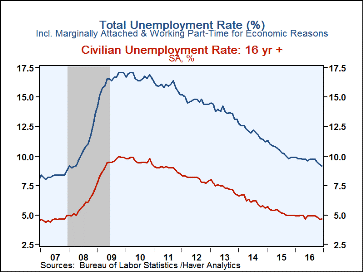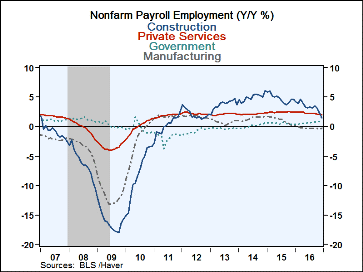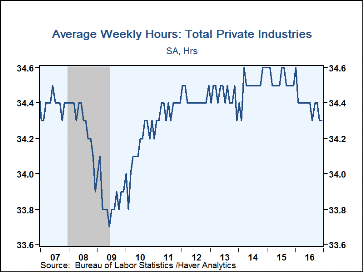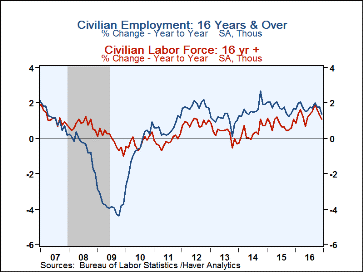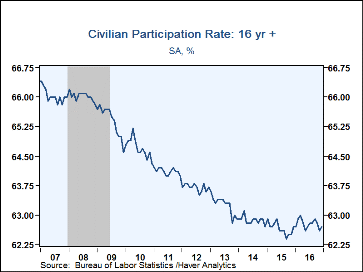 Global| Jan 06 2017
Global| Jan 06 2017U.S. Payroll Increase Eases as Earnings Accelerate
by:Tom Moeller
|in:Economy in Brief
Summary
Nonfarm payroll employment increased 156,000 during December (1.4% y/y) following a 204,000 November increase and a 135,000 October rise. Revisions added 19,000 jobs to these two latter results combined. A 175,000 increase in December [...]
Nonfarm payroll employment increased 156,000 during December (1.4% y/y) following a 204,000 November increase and a 135,000 October rise. Revisions added 19,000 jobs to these two latter results combined. A 175,000 increase in December payrolls was expected in the Action Economics Forecast Survey. During all of 2016, payrolls improved an average of 180,000 per month, the weakest rise since 2012. Average hourly earnings increased 0.4% following a 0.1% decline. A 0.3% gain had been expected. The y/y rise of 2.9% was the quickest since June 2009. The unemployment rate notched higher to an expected 4.7%. The overall unemployment rate including marginally attached and those working part-time for economic reasons fell to 9.2%, its lowest level since April 2008.
From the payroll employment survey, the 156,000 increase in jobs reflected a modest 12,000 increase (-0.1 % y/y) in the goods-producing sector. Factory employment gained 17,000 (-0.4% y/y) following four consecutive monthly declines. Construction sector jobs eased 3,000 (+1.5% y/y), the first down month since August. Mining sector jobs fell 2,300. The 10.7% y/y contraction in mining jobs last year follows a 15.6% decline in 2015.
Private service sector employment increased 132,000 (1.9% y/y), the weakest rise since May. It reflected a depressed 15,000 (2.7% y/y) rise in professional & business services employment, after a 44,000 average monthly gain during 2016. Temporary help services jobs declined 15,500 (+1.6% y/y), the first fall since August. Leisure & hospitality jobs also rose a lessened 24,000, and the y/y increase of 1.9% was down from a peak 3.5% gain during all of 2013. The number of retail jobs rose a lessened 6,300 (1.3% y/y). Information sector employment fell 6,000 and was unchanged y/y. Employment improvement was registered in health care & social assistance where the number of jobs increased 63,300 (2.5% y/y), the strongest monthly rise since October 2015. Financial activities employment also advanced a strengthened 13,000 (1.9% y/y), the biggest increase since August. Government sector employment increased 12,000 (0.8% y/y) as federal sector hiring rose 5,000 (1.3% y/y). State government payrolls fell 4,000 and were unchanged y/y. Local government jobs increased 11,000 (1.0% y/y).

Average hourly earnings increased 0.4% and recouped November's 0.1% decline. The 2.9% y/y gain in pay reflected a 4.4% y/y rise in leisure & hospitality pay as well as information sector earnings. Factory sector earnings grew 3.4% y/y and construction sector pay gained 3.0% y/y. Professional & business services earnings also increased 3.0% y/y. On the weak side, financial sector pay improved 2.4% and education & health services earnings grew 1.8% y/y.
The length of the average workweek held at 34.3 hours and equaled the shortest numbers of hours worked since early 2014. Private service sector hours remained depressed at 33.3, down from the 2015 high of 33.4 hours. Factory sector hours have been fairly stable at 40.7 hours, but construction sector hours were depressed at 38.7.
From household employment survey, the unemployment rate ticked higher to 4.7% from 4.6%. It reflected a 63,000 rise (1.4% y/y) in employment and a 184,000 increase (1.1% y/y) in the labor force. The population grew 1.1% y/y, leaving the labor force participation rate at 62.7%. That was below the 63.0% high reached in March. The median duration of unemployment fell to 10.8 weeks last year, the lowest reading since 2008 and below the 2010 figure of 21.5 weeks.
Teenage unemployment stood at 15.7% last year, down from the 25.9% high in 2010. Unemployment amongst workers aged 25-34 years averaged 5.0%, half the 2010 high. The unemployment rate for those aged 35-44 was 3.8% and below the 2010 high of 8.1%. For those aged 45-54 years old, unemployment averaged 3.5%, below the 7.7% high in 2010. Unemployment amongst those aged 55 and over was 3.6% last year versus 7.0% at its high.
By educational attainment, persons with less than a high school diploma were 7.4% unemployed last year. High school graduates with no college were 5.2% unemployed, and joblessness amongst individuals with less than a bachelors degree was 4.1%. College graduates registered a 2.5% unemployment last year.
The labor market data are contained in Haver's USECON database. Detailed figures are in the EMPL and LABOR databases. The expectations figure is in the AS1REPNA database.
| Employment: (SA, M/M Change, 000s) | Dec | Nov | Oct | Dec Y/Y | 2016 | 2015 | 2014 |
|---|---|---|---|---|---|---|---|
| Payroll Employment | 156 | 204 | 135 | 1.4% | 1.7% | 2.1% | 1.9% |
| Previous | -- | 178 | 142 | -- | -- | -- | -- |
| Manufacturing | 17 | -7 | -4 | -0.4 | -0.2 | 1.1 | 1.4 |
| Construction | -3 | 17 | 14 | 1.5 | 3.3 | 4.8 | 5.0 |
| Private Service-Producing | 132 | 185 | 138 | 1.9 | 2.2 | 2.5 | 2.1 |
| Government | 12 | 6 | -11 | 0.7 | 0.6 | 0.6 | 0.1 |
| Average Weekly Hours - Private Sector | 34.3 | 34.3 | 34.4 | 34.5 | 34.4 | 34.5 | 34.5 |
| Private Sector Average Hourly Earnings (%) | 0.4 | -0.1 | 0.4 | 2.9 | 2.6 | 2.3 | 2.1 |
| Unemployment Rate (%) | 4.7 | 4.6 | 4.8 | 5.0 | 4.8 | 5.3 | 6.2 |
Tom Moeller
AuthorMore in Author Profile »Prior to joining Haver Analytics in 2000, Mr. Moeller worked as the Economist at Chancellor Capital Management from 1985 to 1999. There, he developed comprehensive economic forecasts and interpreted economic data for equity and fixed income portfolio managers. Also at Chancellor, Mr. Moeller worked as an equity analyst and was responsible for researching and rating companies in the economically sensitive automobile and housing industries for investment in Chancellor’s equity portfolio. Prior to joining Chancellor, Mr. Moeller was an Economist at Citibank from 1979 to 1984. He also analyzed pricing behavior in the metals industry for the Council on Wage and Price Stability in Washington, D.C. In 1999, Mr. Moeller received the award for most accurate forecast from the Forecasters' Club of New York. From 1990 to 1992 he was President of the New York Association for Business Economists. Mr. Moeller earned an M.B.A. in Finance from Fordham University, where he graduated in 1987. He holds a Bachelor of Arts in Economics from George Washington University.



